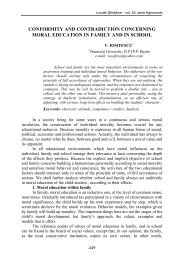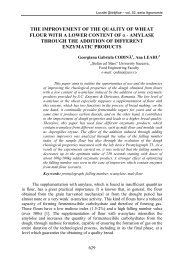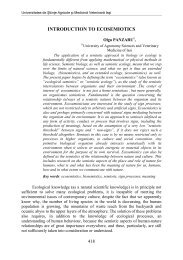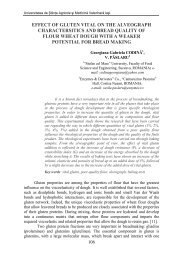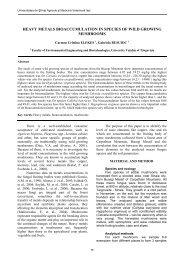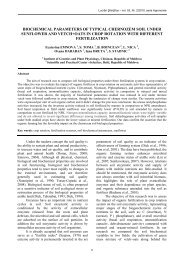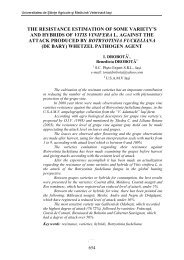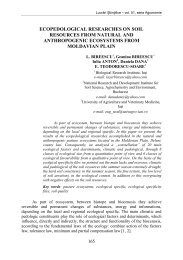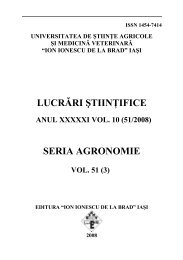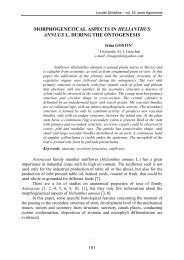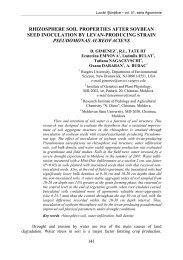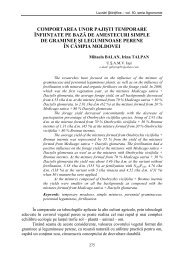environmental impact on yield of pea and okra grown under ...
environmental impact on yield of pea and okra grown under ...
environmental impact on yield of pea and okra grown under ...
Create successful ePaper yourself
Turn your PDF publications into a flip-book with our unique Google optimized e-Paper software.
Universitatea de Ştiinţe Agricole şi Medicină Veterinară Iaşi<br />
RESULTS AND DISCUSSION<br />
Effect <strong>of</strong> Intercropping Pea / Okra <strong>on</strong> Air <strong>and</strong> Soil Heat Units VS Pea<br />
Yield<br />
Average air <strong>and</strong> soil heat units for <strong>pea</strong> as it was <strong>grown</strong> <strong>under</strong> sole cropping<br />
<strong>and</strong> intercropping are presented in table 1A. It is clear that the variati<strong>on</strong>s in the<br />
values <strong>of</strong> soil heat unit <strong>under</strong> <strong>pea</strong> sole crop <strong>and</strong> <strong>pea</strong> intercropped with <strong>okra</strong> are<br />
more pr<strong>on</strong>ounced than those <strong>of</strong> the air heat unit, where a reducti<strong>on</strong> <strong>of</strong> soil heat unit<br />
<strong>under</strong> <strong>pea</strong> intercropping was ranged between 60-133.3 as compared to <strong>pea</strong> sole<br />
cropping, while for air heat unit the reducti<strong>on</strong> was ranged between 2.9-15.3.<br />
Batugal et. al (1990) explained the reducti<strong>on</strong> in soil temperature to be due to<br />
radiati<strong>on</strong> reflecti<strong>on</strong>, shading effect <strong>of</strong> the taller crop <strong>and</strong> water c<strong>on</strong>serving<br />
properties <strong>under</strong> intercropping system. However, in the present study, the water<br />
c<strong>on</strong>servati<strong>on</strong> has not been clearly dem<strong>on</strong>strated. Moreover, a significant reducti<strong>on</strong><br />
<strong>of</strong> air <strong>and</strong> soil heat unit was obtained when <strong>pea</strong> was planted with <strong>okra</strong> <strong>under</strong> 1: 2<br />
<strong>and</strong> 2: 1 row arrangements as compared to <strong>pea</strong> sole crop. Where soil heat unit<br />
gave a decrease <strong>of</strong> 133.3 <strong>and</strong> 123.0, respectively. While air heat unit gave a<br />
decrease <strong>of</strong> 15.3 <strong>and</strong> 9.3, respectively, compared to its sole crop. This could be<br />
explained by the shading development effect caused by <strong>okra</strong> plants. Moreover, the<br />
significant higher <strong>yield</strong>s <strong>of</strong> <strong>pea</strong> (Table3) were obtained <strong>under</strong> the same treatments<br />
(1:2 <strong>and</strong> 2:1), where the maximum reducti<strong>on</strong> <strong>of</strong> soil <strong>and</strong> air heat unit were<br />
recorded. Therefore, the shading development gave optimum values <strong>of</strong> soil <strong>and</strong><br />
heat unit that affected significantly <strong>yield</strong> <strong>of</strong> <strong>pea</strong> especially <strong>under</strong> hot dry summer<br />
c<strong>on</strong>diti<strong>on</strong>s. This agrees with the findings <strong>of</strong> Sharaiha <strong>and</strong> Battikhi (2002) <strong>on</strong> their<br />
work <strong>on</strong> potato / corn intercropping <strong>and</strong> with Batugal et al (1990) <strong>on</strong> their work <strong>on</strong><br />
potato / maize intercropping.<br />
Effect <strong>of</strong> Intercropping Pea / Okra <strong>on</strong> Light intercepti<strong>on</strong> VS Pea Yield<br />
Intercropping <strong>pea</strong> with <strong>okra</strong> <strong>under</strong> different row arrangements (1:1, 1:2, 2:1,<br />
<strong>and</strong> 2:2) resulted in a reducti<strong>on</strong> <strong>of</strong> light intercepti<strong>on</strong> as compared with <strong>pea</strong> sole crop<br />
(Table 1A). However, significant maximum reducti<strong>on</strong> was obtained <strong>under</strong> 1:2 <strong>pea</strong> /<br />
<strong>okra</strong> row arrangement, where it gave a decrease in light intercepti<strong>on</strong> <strong>of</strong> 110.6 µ mol<br />
m¯²s¯¹ as compared to the value obtained <strong>under</strong> <strong>pea</strong> sole crop. This could be<br />
attributed to the shading effect <strong>of</strong> <strong>okra</strong> plants <strong>on</strong> <strong>pea</strong>, since <strong>pea</strong> was planted<br />
between double rows <strong>of</strong> <strong>okra</strong> in each side. On the other h<strong>and</strong>, the highest<br />
significant <strong>yield</strong> <strong>of</strong> <strong>pea</strong> was obtained <strong>under</strong> the lowest value <strong>of</strong> light intercepti<strong>on</strong><br />
(1:2 <strong>pea</strong> / <strong>okra</strong> intercropping) where it gave an increase in <strong>yield</strong> <strong>of</strong> 45.6% over the<br />
<strong>yield</strong> <strong>of</strong> <strong>pea</strong> sole crop (Table3). However, the other intercropping treatments<br />
showed no significant differences in average light intercepti<strong>on</strong> compared to <strong>pea</strong><br />
sole crop, although <strong>yield</strong> <strong>of</strong> <strong>pea</strong> <strong>grown</strong> with <strong>okra</strong> in 2:1 row arrangement gave<br />
significant higher <strong>yield</strong> over its sole crop. Therefore, other factors might play an<br />
important role that affected positively the <strong>yield</strong> <strong>of</strong> <strong>pea</strong> as it was intercropped with<br />
<strong>okra</strong> in 2:1 row arrangement, such as evapotranspirati<strong>on</strong>, water use efficiency<br />
(Table 2A) air <strong>and</strong> soil heat unit (Table 1A) in additi<strong>on</strong> to the canopy development.<br />
316




